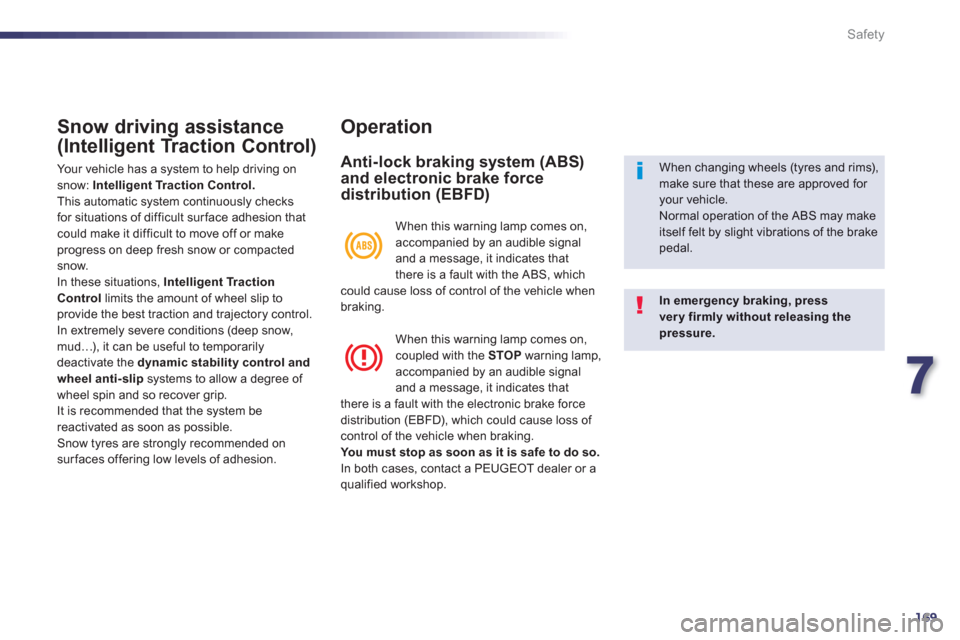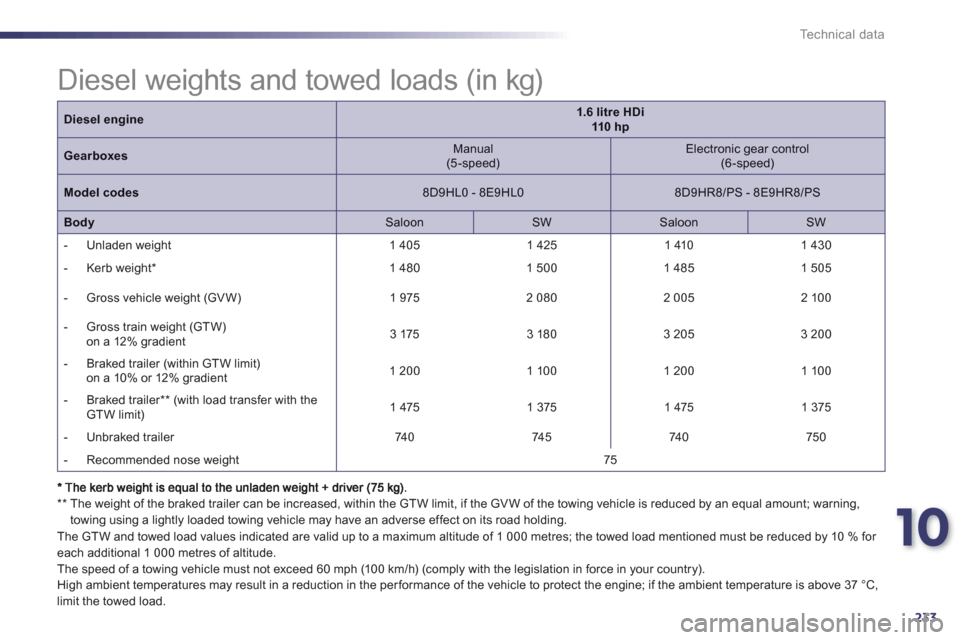Page 171 of 340

7
169
Safety
Snow driving assistance
(Intelligent Traction Control)
Your vehicle has a system to help driving on snow: Intelligent Traction Control. This automatic system continuously checks for situations of difficult surface adhesion thatcould make it difficult to move off or makeprogress on deep fresh snow or compacted snow.
In these situations, Intelligent Traction
Controllimits the amount of wheel slip to provide the best traction and trajectory control.
In extremely severe conditions (deep snow,mud…), it can be useful to temporarilydeactivate the dynamic stability control andwheel anti-slip
systems to allow a degree of
wheel spin and so recover grip.
It is recommended that the system be
reactivated as soon as possible.
Snow t
yres are strongly recommended on sur faces offering low levels of adhesion.
Operation
Anti-lock braking system (ABS)and electronic brake force
distribution (EBFD)
In emergency braking, press very firmly without releasing the pressure.
When changing wheels (tyres and rims),make sure that these are approved for your vehicle.
Normal operation of the ABS may makeitself felt by slight vibrations of the brake pedal. When this warnin
g lamp comes on,
accompanied by an audible signal
and a message, it indicates that
there is a fault with the ABS, which could cause loss of control of the vehicle whenbraking.
When this warnin
g lamp comes on,coupled with the STOPwarning lamp,
accompanied by an audible signaland a message, it indicates that
there is a fault with the electronic brake forcedistribution (EBFD), which could cause loss of control of the vehicle when braking.
You must stop as soon as it is safe to do so.In both cases, contact a PEUGEOT dealer or a qualified workshop.
Page 198 of 340
196
Practical information
1.Brake lamps (light emittingdiodes - LEDs).2. Reversing lamps (P21W).3.Direction indicators (PY21W amber).4.Sidelamps (light emittingdiodes - LEDs).5.Foglamps (H21W).
Rear lamps (Saloon)
Reversing lamp, direction
indicator and foglamp bulbs
F Open the boot, then the plastic cover. F
Remove the two lamp unit fixing nuts. F
Extract the lamp unit carefully from the outside.F
Disconnect the electrical connector.
F
Spread the six tabs and remove the bulb holder. F
Turn the bulb a quar ter of a turn and pull it out.
For reassembly, carry out these operations in
reverse order.
Changing the light emittingdiode-LED lamps
For replacement, contact a PEUGEOT dealer or qualified workshop.
Page 199 of 340
8
197
Practical information
1.Brake lamps (light emittingdiodes - LEDs).2.Reversing lamps (W19W).3.Direction indicators (PY21W amber).4.Sidelamps (light emittingdiodes - LEDs).5.Foglamps (light emittingdiodes - LEDs).
Rear lamps (SW)
FOpen the boot then remove the accesscover.
FRemove the sealing foam.FDisconnect the lamp connector. FRemove the lamp fixing nut.
Direction indicators(on the wings)
F
Carefully remove the lamp unit from outside.F
Remove the sealing foam. F
Unclip the bulb holder. F
Turn the bulb a quar ter of a turn and pull itout.
For reassembly, carry out these operations in
reverse order.
Changing the light emitting diode-LED lamps
For replacement, contact a PEUGEOT dealer or qualified workshop.
Page 201 of 340
8
199
Practical information
Third brake lamp (light emittingdiodes - LEDs)
Contact a PEUGEOT dealer or qualified
workshop.
Number plate lamps
FInsert a thin screwdriver into one of the outer holes of the lens.FPush it outwards to unclip.FDisconnect the lamp connector.
FRemove the lens.
FPull the bulb out and change it.
Page 214 of 340

212
Practical information
Driving advice
Distribution of loads
FDistribute the load in the trailer so that theheaviest items are as close as possible to
the axle and the nose weight approaches
the maximum permitted without
excee
ding it.
Air density decreases with altitude, thus reducingengine performance. Above 1 000 metres, the maximum towed load must be reduced by 10 %
for every 1 000 metres of altitude.
Side wind
FTake into account the increased sensitivity
to side wind.
Cooling
To w i ng a trailer on a slope increases the
temperature of the coolant.
As the fan is electricall
y controlled, its cooling capacity is not dependent on the engine speed.
F
To lower the engine speed, reduce your speed.
The maximum towed load on a long incline
depends on the
gradient and the ambient
temperature.
In all cases, keep a check on the coolant
temperature.
FIf the warning lamp and the
STOP warning lamp come on, stop the vehicle and switch off
the engine as soon as possible.
Braking
To w i ng a trailer increases the braking distance.
To avoid overheating of the brakes on a longmountain type of descent, the use of engine braking is recommended.
Tyres
F
Check the tyre pressures of the towingvehicle and of the trailer, obser ving the recommended pressures.
Lighting
F
Check the electrical lighting and signalling on the trailer.
The rear parking sensors will be deactivated automatically if a genuine PEUGEOT towbar is used.
R
efer to the "Technical Data" section for details
of the weights and towed loads which apply to your vehicle.
Page 230 of 340

228
Technical data
*
The kerb weight is equal to the unladen weight + driver (75 kg). **
The weight of the braked trailer can be increased, within the GTW limit, if the GVW of the towing vehicle is reduced by an equal amount; warning,
towing using a lightly loaded towing vehicle may have an adverse effect on its road holding.
Petrol weights and towed loads (in kg)
The GTW and towed load values indicated are valid up to a maximum altitude of 1 000 metres; the towed load mentioned must be reduced by 10 % for each additional 1 000 metres of altitude.
The speed of a towing vehicle must not exceed 60 mph (10 0 km/h) (comply with the legislation in force in your country).
High ambient temperatures may result in a reduction in the performance of the vehicle to protect the engine; if the ambient temperature is above 37 °C,
limit the towed load.
Petrol engines1.6 litre V Ti120 hp1.6 litre THP156 hp
GearboxesElectronic gear control(6-speed)
Manual(6-speed)
Automatic(6-speed)
Model codes
8D5FH8/P - 8E5FH8/P 8D5FS8/P - 8E5FS8/P 8D5FV8 - 8E5FV8
8D5FNA - 8E5FNA 8D5FVA - 8E5FVA
BodySaloon
SW
Saloon SW
Saloon
SW
- Unladen wei
ght 1 390
1 410
1 400
1 420
1 410
1 430
- Kerb weight *
1 465 1 485
1 475 1 495
1 485
1 505
- Gross vehicle wei
ght (GV W)
1 945 2 0551 9952 080
2 015 2 10 0
- Gross train weight (GTW)
on a 12 % gradient 3 3453 355
3 595
3 5803 515
3 600
- Braked trailer
(within GTW limit) on a 10 % or 12 % gradient1 400
1 3001 6001 500
1 600
1 500
- Braked trailer ** (with load transfer within the
GTW limit) 1 675 1 575 1 875 1 7751 875 1 775
-
Unbraked trailer
730
740735
745
740
750
- Recommended nose weight 7575
Page 231 of 340

10
229
Technical data
Petrol engine1.6 litre THP 160 hp
Gearbox
Manual(6-speed)
Model code
-
Body
Saloon
SW
- Unladen wei
ght -
-
- Kerb weight
*-
-
- Gross vehicle wei
ght (GV W)
-
-
-
Gross train weight (GTW)
on a 12 % gradient --
- Braked trailer (within GTW limit) on a 10 % or 12 % gradient--
- Braked trailer ** (with load transfer within the
GTW limit) -
-
-
Unbraked trailer --
- Recommended nose weight
-
*
The kerb weight is equal to the unladen weight + driver (75 kg). **
The weight of the braked trailer can be increased, within the GTW limit, if the GVW of the towing vehicle is reduced by an equal amount; warning,
towing using a lightly loaded towing vehicle may have an adverse effect on its road holding.
Petrol weights and towed loads (in kg)
The GTW and towed load values indicated are valid up to a maximum altitude of 1 000 metres; the towed load mentioned must be reduced by 10 % for each additional 1 000 metres of altitude.
The speed of a towing vehicle must not exceed 60 mph (10 0 km/h) (comply with the legislation in force in your country).
High ambient temperatures may result in a reduction in the performance of the vehicle to protect the engine; if the ambient temperature is above 37 °C,
limit the towed load.
Page 235 of 340

10
233
Technical data
**
The weight of the braked trailer can be increased, within the GTW limit, if the GVW of the towing vehicle is reduced by an equal amount; warning,
towing using a lightly loaded towing vehicle may have an adverse effect on its road holding.
The
GTW and towed load values indicated are valid up to a maximum altitude of 1 000 metres; the towed load mentioned must be reduced by 10 % for each additional 1 000 metres of altitude.
The speed of a towing vehicle must not exceed 60 mph (10 0 km/h) (comply with the legislation in force in your country).
High ambient temperatures may result in a reduction in the performance of the vehicle to protect the engine; if the ambient temperature is above 37 °C,
limit the towed load.
Diesel weights and towed loads (in kg)
Diesel engine1.6 litre HDi 110 hp
Gearboxes
Manual(5-speed)
Electronic gear control (6-speed)
Model codes8D9HL0 - 8E9HL0
8D9HR8/PS - 8E9HR8/PS
BodySaloonSW
SaloonSW
- Unladen wei
ght 1 4051 425 1 410
1 430
- Kerb weight
*
1 480 1 500
1 485 1 505
- Gross vehicle wei
ght (GV W)
1 975 2 080
2 005 2 10 0
-
Gross train weight (GTW)
on a 12% gradient 3 175
3 180
3 205
3 200
- Braked trailer
(within GTW limit) on a 10% or 12% gradient
1 200
1 100
1 200
1 100
- Braked trailer **
(with load transfer with the
GTW limit) 1 475
1 375
1 475
1 375
-
Unbraked trailer
740
745740
750
- Recommended nose wei
ght
75